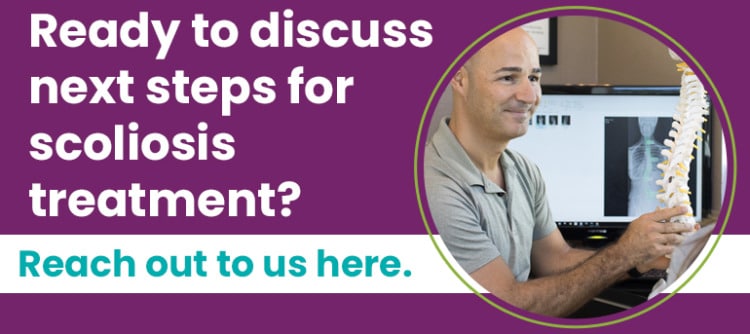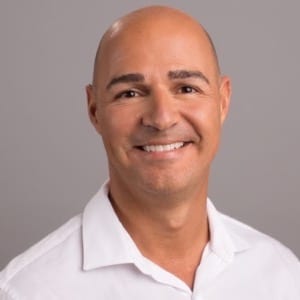What Is The Best Treatment For Scoliosis? Effective Options

It's important for patients to understand that there are different ways to treat scoliosis, with different potential results. In fact, following a diagnosis, the most important decision to be made is the type of treatment approach to commit to.
The best treatment for scoliosis is proactive and impacts conditions on every level. Conservative treatment preserves as much of the spine's natural curves as possible and is best for the spine's long-term health and function.
As a progressive condition, scoliosis treatment is about managing an ongoing condition and counteracting its progressive nature.
Table of Contents
Scoliosis Progression
Scoliosis causes the spine to bend unnaturally to the side and twist, and as a progressive condition, it's virtually guaranteed to become more severe over time.
We don't always know what causes scoliosis to develop initially, but we know how to treat it effectively, and we know what makes it progress: growth.
Childhood scoliosis should always be taken seriously because it can worsen quickly as a child grows.
Babies can be born with congenital scoliosis. Infantile scoliosis is diagnosed between the ages of 6 months and 3 years of age, and juvenile scoliosis affects children between the ages of 3 and 10, with adolescent scoliosis diagnosed between 10 and reaching skeletal maturity.
Adolescent idiopathic scoliosis is the most prevalent type of scoliosis overall.
Adult scoliosis is diagnosed once skeletal maturity has been reached, and degenerative scoliosis affects older adults and is caused by natural age-related spinal degeneration.
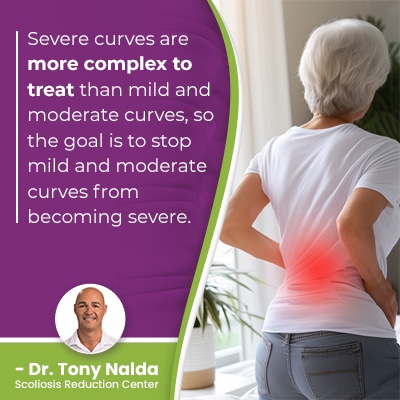 As a progressive condition, even a diagnosis of mild scoliosis doesn't mean that's where it will stay; without treatment, mild scoliosis can easily progress to become moderate scoliosis, severe, and very severe scoliosis.
As a progressive condition, even a diagnosis of mild scoliosis doesn't mean that's where it will stay; without treatment, mild scoliosis can easily progress to become moderate scoliosis, severe, and very severe scoliosis.
Severe curves are more complex to treat than mild and moderate curves, so the goal is to stop mild and moderate curves from becoming severe.
The larger a scoliosis curve becomes, the more noticeable its symptoms and effects will be, and these effects commonly include postural changes and pain.
Postural Changes
Postural changes are the main symptoms of childhood scoliosis and are caused by the condition's uneven forces disrupting the body's overall symmetry.
Common postural changes include uneven shoulders, hips, shoulder blades, the development of a rib cage arch, and arms and legs that appear to hang at different lengths.
Changes to movement are also common as the spine's misalignment transfers to the body, disrupting its alignment from the head to the feet; disruptions to balance, coordination, and gait are also common effects.
Postural changes are difficult for children and can lead to negative self image and body issues: another reason to work towards preventing their development.
While children can experience varying degrees of muscle pain, back pain is more closely associated with adult scoliosis.
Scoliosis Pain
Scoliosis pain relief is a focus of adult scoliosis treatment as the condition becomes compressive once skeletal maturity has been reached.
Compression is uneven pressure and is the main cause of condition-related pain.
In children whose spines are still growing, the constant lengthening motion of growth counteracts the compressive force of the unnatural spinal curve, but in adults who have stopped growing, the uneven pressure affects the spine, its surrounding muscles, nerves, and the entire body.
Scoliosis pain can involve the muscles, the back, and the most common symptom of adult scoliosis is radiating pain in the extremities due to nerve compression.
Pain in the hands and feet is the most common scoliosis symptom that brings adults in to see me for a diagnosis and treatment.
Just like postural changes will become more overt with progression, scoliosis pain will also increase as the spine becomes more unnaturally tilted and twisted.
Scoliosis Treatment Options
Scoliosis treatment options need to be proactive to work towards preventing progression and the need for more invasive forms of treatment in the future.
When it comes to scoliosis treatment, there are two main choices: traditional or conservative treatment.
Traditional scoliosis treatment offers a surgical response, while a conservative approach provides an effective non-surgical alternative with proven results.
Scoliosis surgery is a type of spinal fusion, and it shapes the spine's long-term health very differently than a conservative treatment response.
Traditional Scoliosis Treatment: Spinal Fusion
Traditional scoliosis treatment was the dominant choice for many years, but that doesn't mean it was the best or only treatment option available.
Traditional scoliosis treatment isn't proactive, it's reactive.
While conservative treatment is proactive because it;'s started immediately following a diagnosis in the interest of preventing progression, while traditional treatment is more about reacting once a certain amount of progression has already occurred.
A defining feature of a traditional treatment response is that it commonly recommends watching and waiting while conditions are mild and moderate, but when/if conditions progress into the severe classification, surgery can be presented as the only remaining recourse.
Spinal fusion surgery is invasive and risky. It involves determining the curve's most-tilted vertebrae, removing the discs that sit between adjacent vertebrae to be fused, fusing the vertebrae together into one solid bone, and attaching metal rods to the spine to hold it in place.
Effects of Scoliosis Surgery
A fused spine will be straighter, but the way it achieves this is contrary to the spine's movement-based design so can come at a cost: the spine's flexibility, range of motion, and strength.
Risks associated with the procedure itself include excessive blood loss, adverse reaction to hardware used, infection, and nerve damage.
As the brain and spine work in tandem to form the body's central nervous system (CNS), nerve damage is also a potential risk of spinal surgery, and once a nerve is damaged, it can be difficult, if not impossible, to reverse the damage.
A spine that's fused is one that will be more rigid and immovable, and increased pain at the fusion site is also common.
If the spine loses its range of motion and flexibility, activity restrictions can become part of life, and a spine that's fused will always be weaker and more vulnerable to injury.
In addition, once a spine is fused, it's fused for life. If the procedure fails or hardware malfunctions over time, the only recourse is more surgery and facing increasing risks with each subsequent spinal surgery.
Conservative Non-Surgical Scoliosis Treatment
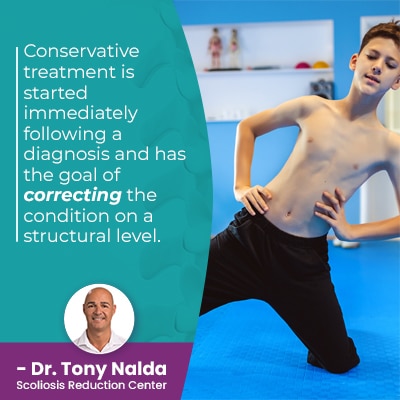 Here at the Scoliosis Reduction Center®, patients benefit from a proactive treatment approach that combines the power of multiple scoliosis-specific treatment disciplines.
Here at the Scoliosis Reduction Center®, patients benefit from a proactive treatment approach that combines the power of multiple scoliosis-specific treatment disciplines.
Conservative treatment doesn't carry the same potential risks, side effects, and complications.
Conservative treatment is started immediately following a diagnosis and has the goal of correcting the condition on a structural level.
As a structural condition, scoliosis needs to be primarily addressed structurally.
Condition-specific chiropractic treatment works towards repositioning the curve's most-tilted vertebrae back into alignment with the rest of the spine, and structural changes need to be supported by strong muscles.
Physical therapy and scoliosis-specific exercises work towards improving the spine's surrounding muscle balance and strength for more support and stability for the spine.
Improving posture is also important, and mirror-image exercises specific to a patient's curve type can help with postural awareness and remodeling.
Corrective bracing can help augment corrective treatment results by pushing the spine into a straighter alignment.
Rehabilitation is the ongoing portion of treatment and can involve customized exercises to further heal and stabilize the spine from home.
The Center's results speak for themselves, and when successful, scoliosis that's treated conservatively can mean a spine that's strong and flexible.
Conclusion
The best treatment for scoliosis is an approach that's proactive and corrective.
While there are never treatment guarantees, conditions that are diagnosed and treated early are simpler to treat.
Curve progression can be counteracted with treatment, and there are four main types of scoliosis: idiopathic scoliosis, neuromuscular scoliosis, degenerative scoliosis, and congenital scoliosis.
Condition type is determined by causation, and effective treatment plans are shaped around important factors such as patient age, condition type, severity, and curvature location.
While there is no way to prevent scoliosis, there is a way to prevent it from getting worse: being proactive with conservative treatment.
Most patients will be diagnosed through a physical examination and X-ray results, and most children will progress faster than adults due to growth triggering progression.
People with scoliosis need to understand that the condition can change over time, and there are a number of benefits associated with early detection and intervention.
Larger curves are likely to continue progressing, and adolescents are the most at risk for rapid-phase progression due to the rapid and unpredictable growth spurts of puberty.
If you, or someone you care about, has been recently diagnosed, don't hesitate to reach out for assessment, diagnosis, and treatment.
Dr. Tony Nalda
DOCTOR OF CHIROPRACTIC
After receiving an undergraduate degree in psychology and his Doctorate of Chiropractic from Life University, Dr. Nalda settled in Celebration, Florida and proceeded to build one of Central Florida’s most successful chiropractic clinics.
His experience with patients suffering from scoliosis, and the confusion and frustration they faced, led him to seek a specialty in scoliosis care. In 2006 he completed his Intensive Care Certification from CLEAR Institute, a leading scoliosis educational and certification center.
About Dr. Tony Nalda
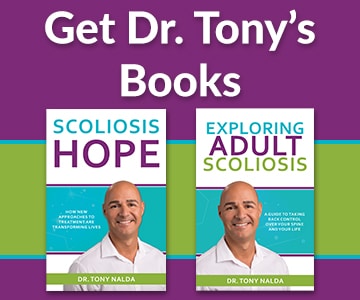 Ready to explore scoliosis treatment? Contact Us Now
Ready to explore scoliosis treatment? Contact Us Now